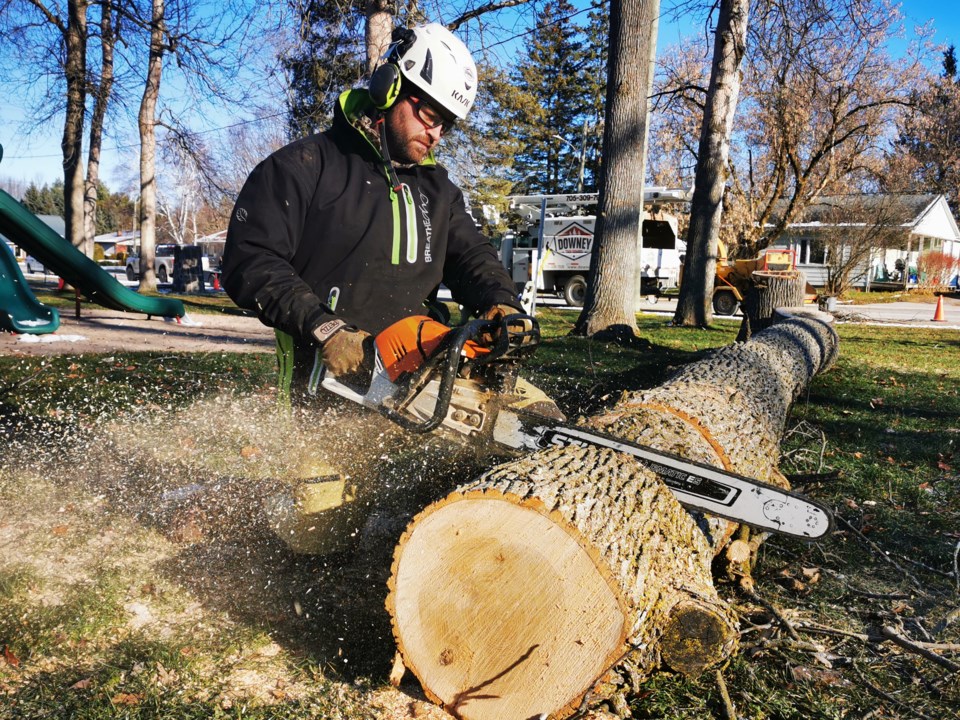Over the past 20 years, the emerald ash borer has decimated millions of trees across Canada.
Earlier this week, a four-person crew from Downey Tree Service started the task of removing a dozen ash trees from Bishop Park in Elmvale, all of them killed by the metallic wood-boring beetle.
“The trees have been posing a threat to the roadway and the playground,” said Ryan Downey, owner and lead arborist at Downey Tree Service, which is based in Minesing. “All of these trees have, unfortunately, succumbed to emerald ash borer.”
The township said Bishop Park would be closed on Wednesday and Thursday for the removal of 12 trees affected by the emerald ash borer.
A highly invasive insect, the emerald ash borer is believed to have arrived in North America in the early 1990s on wooden pallets from East Asia, its native habitat.
The beetle was first detected in Canada, near Windsor, in 2002 and has since spread to 30 states and five provinces, according to the Natural Resources Canada website. The website says up to 99 per cent of all ash trees are killed within eight to 10 years once the beetle arrives.
Downey’s experience suggests the emerald ash borer kills at a much quicker rate.
“Within 12 to 18 months, they can go from fully alive and healthy to fully dead and hazardous,” he said. “Essentially they’ll get into the canopy of the trees and spread from there. You’ll see dieback in the trees starting from the top down.”
According to Downey, it’s the emerald ash borer larvae that does the majority of the damage.
“It bores through the vascular cambium (the main growth tissue in the stems and roots of many plants), essentially disrupting all of the vascular activity and transportation of nutrients and minerals, eventually leading to the death of the trees,” he said.
While the beetle has been identified in the local area since the early 2000s, Downey said it has become a major problem in Ontario over the past decade.
“Springwater Township, in particular, is currently being completely devastated by this insect,” he said. “Four out of every five days, for the average tree service, involves ash tree removals of some type.”
Downey said homeowners who have ash trees should be extra vigilant and keep a keen eye out for any changes in their trees. If they see anything out of the ordinary, they should call a certified arborist.
“Arborists know the signs and symptoms of emerald ash borer better than the regular person,” he said. “We can mitigate a lot of the expenditure.”
According to Downey, once an ash tree is attacked by the emerald ash borer, it becomes a threat and/or liability for the property owner because it deteriorates at such a rapid rate.
Downey said an infested ash tree will become extremely brittle, which makes traditional forms of tree removal more difficult, if not impossible.
“Once they are dead, they quickly become too hazardous to climb and rope with traditional methods,” he said. “We need to involve much more expensive equipment, such as spider lifts and mobile cranes. The cost will go up three, four or five times.”
Something Downey has noticed with recent ash tree removals, and it concerns him a great deal, is tree-base failure, meaning the roots have deteriorated to such a point that a gentle breeze could topple the tree.
“The ash trees we’re looking at today, some of them are 70, 80 or 90 feet tall,” he said. “Unlike sugar maples and red oaks, we’re seeing a lot of ash trees failing right at the base, causing catastrophic damage.”
Downey recommends homeowners who are concerned about the health of their trees call a certified arborist to ensure the work is done correctly and the homeowner is protected.
He said the first thing to do, for the safety of the homeowner and their neighbours, is make sure the company you hire is fully insured with a commercial liability policy, is Workplace Safety and Insurance Board (WSIB) compliant and they have a certified arborist on staff, one who has been certified by the International Society of Arboriculture or through the Ontario College of Trades program.
“Understanding the tree is the most important part of this job,” Downey said. “You need to understand all different types and species of trees and be backed by a good insurance policy to make sure everything goes off without a hitch.”
